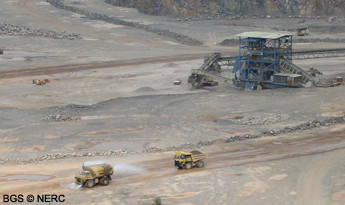
Quarrying and the environment
Introduction | Landscape | Planning controls | Water and caves | Dust, noise and traffic | Blasting | Nature conservation
Dust, noise, and traffic
Dust, noise and traffic complaints have been an issue for many years, ever since output increased as demand for road materials grew in the 1900s. Many early complaints and court cases were about dust and solid tyred steam lorries and trailers ripping up road surfaces, until they were outlawed in the 1930s. Lime burning caused smoky fumes and dust particularly in villages such as Gurney Slade. Dust whipped up from the quarries themselves and by lorries carrying stone as well as traffic on narrow roads again became key issues in the 1970s with the motorway boom.
A combination of planning conditions (often now running into 60–80 per consent), national and European legislation and official, company or trade federation guidelines have resulted in considerable positive changes in standards in the last 30 years.
For example, all lorries carrying granular materials (powders or aggregates) have to be sheeted; and wheel washers are installed at quarry exits and both local and quarry roads are sprayed with water. Indeed in eastern Mendip, the companies have come together as the Mendip Quarry Producers and one of the outcomes has been to ensure that this is carried out systematically.

There have been major changes in the way stone is transported over the last 30 years. Foster Yeoman (Aggregate Industries) and Hanson now move stone by rail, via their devolved company, Mendip Rail. Up to 75% of Torr Works annual output of 6 million tonnes is now sent this way. However, this is only really viable for longer or mass movement journeys. There has also been a switch from company vehicles to owner or contract vehicles although often still in company livery. Apart from Highway Authority powers, companies usually operate guidelines on routes and speeds to be used, for example setting maximum speed limits through villages, and making compliance a condition of sale or contract.
A further change has been that of contracting out most quarry activities such as stripping overburden, blasting, internal transport, accounts and the like to specialists. However, the same rules apply. Companies have also developed a contract with the Health and Safety Executive aiming to secure a zero tolerance in respect of accidents. All quarry faces have to be profiled and recorded for blasting and vibration/air pressures monitored and recorded each time. All potentially toxic hazardous or injurious substances have to be carefully stored and used. Activities falling outside certain limits have to be reported.
Drilling rigs (previously a major source of dust) are fitted with filter bags and the dust collected is often passed on to specialist companies for processing to asphalt filler. Roads in quarries are often sprayed with water, especially in summer to reduce dust and internal route-ways are maintained and often surfaced to minimise expensive tyre wear and again, to reduce dust. Rubber and plastics are increasingly used to reduce wear on metal parts and lessen noise in vehicles and plant. Mechanical plant is normally enclosed to lower dust emissions, noise, visual intrusion and for safety reasons. The colour of buildings and their location is often specified in planning conditions.
- Home
- Overview maps
- Locality
areas
- Cheddar Gorge
- Charterhouse
- Blackdown
- Burrington Combe
- Shipham & Rowberrow
- Crook Peak & Axbridge
- Banwell to Churchill
- Priddy
- Harptree & Smitham Hill
- Draycott & Westbury-sub-Mendip
- Wookey Hole & Ebbor Gorge
- Wells
- Great Elm & Vallis Vale
- Mells & the Wadbury Valley
- The Vobster area
- The Whatley area
- Torr Works & Asham Wood
- Beacon Hill
- Stoke St Michael & Oakhill
- Holwell & Nunney
- Shepton Mallet & Maesbury
- Gurney Slade & Emborough
- The Nettlebridge valley
- Geology
- Minerals and mines
- Quarrying
- Caves and karst
- Biodiversity
- Detailed site information
- Acknowledgements
- External links
- Search
- Site map